TYJW1.1 Module Datasheet
Last Updated on : 2025-07-10 02:15:27download
Product overview
Developed by Tuya, TYJW1.1 is a Wi-Fi module that is suitable for serial communication of the 3.3 V TTL. It consists of a highly integrated wireless RF chip (ESP8266EX) and an external flash chip, with an embedded Wi-Fi network protocol stack and rich library functions. TYJW1.1 includes a low-power 32-bit CPU, 2-MB flash memory, and 36-KB SRAM.
TYJW1.1 is an RTOS platform that integrates all function libraries of the Wi-Fi MAC and TCP/IP. On the basis of the serial communication manner, you can develop embedded Wi-Fi products as required.
Features
- Embedded with the low-power 32-bit CPU, which can also function as an application processor
- The clock rate supports 80 MHz and 160 MHz
- Operating voltage: 3.3V
- Peripheral: 1 UART
- Wi-Fi connectivity
- 802.11 b/g/n20
- Channels 1 to 14@2.4 GHz
- Support WPA/WPA2 security mode
- Up to +18dBm output power in 802.11b mode
- Support STA/AP/STA+AP working mode
- Support SmartConfig for Android and iOS devices
- Onboard PCB antenna
- Operating temperature: -20℃ to 85℃
Applications
- Intelligent building
- Smart household and home appliances
- Smart socket and light
- Industrial wireless control
- Baby monitor
- Network camera
- Intelligent bus
Change history
| Update date | Updated content | Version after update |
|---|---|---|
| December 02, 2016 | This is the first release. | V1.0.0 |
| January 23, 2018 | Added the description of of the PCB dimensional tolerance | V1.0.1 |
| June 17, 2020 | Adjusted the format | V2.0.0 |
Module interfaces
Dimensions and footprint
The electrical interface of TYJW1.1 is the PHS connector with a spacing of 2.54 mm.
As shown in the following figure, the dimensions of TYJW1.1 are 57.5±0.35 mm (W)×31.4±0.35 mm (L) ×7.2±0.15 mm (H). The thickness of the PCB is 1.2±0.1 mm.
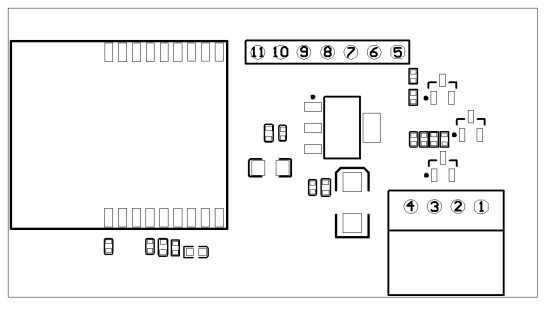
Pin definition
| Pin number | Symbol | Type | Function |
|---|---|---|---|
| 1 | GND | P | Power supply reference ground |
| 2 | TX | I/O | Transmitting interface of the module, output the level of 3.3V TTL |
| 3 | RX | I/O | Receiving interface of the module, input the level of 3.3V TTL |
| 4 | VCC | P | Power supply pin (3.3V) |
Note: P indicates power supply pins and I/O indicates input/output pins.
Definitions on test pins
| Pin number | Symbol | Type | Function |
|---|---|---|---|
| 5 | 3.3V | P | Power supply pin inside the module (3.3V) |
| 6 | IO0 | I/O | The pin for enabling/disabling burning of firmware of the module, whose level needs to be pulled down to the low level during firmware burning. |
| 7 | RST | I/O | Hardware reset pin |
| 8 | TXD0 | I/O | Interface for programming firmware of the module |
| 9 | RXD0 | I/O | Interface for programming firmware of the module |
| 10 | TXD1 | I/O | An interface for displaying information of the module |
| 11 | GND | P | Power supply reference ground |
Note: P indicates power supply pins, and I/O indicates input or output pins. When the pin IO0 is pulled up, the module runs normally. When the pin IO0 is at low level, the module is in firmware programming state.
The RST is only a hardware reset pin and cannot be used for clearing information about Wi-Fi network configuration. The test points are prohibited.
Electrical parameters
Absolute electrical parameters
| Parameter | Description | Minimum value | Maximum value | Unit |
|---|---|---|---|---|
| Ts | Storage temperature | -40 | 105 | ℃ |
| VBAT | Supply voltage | -0.3 | 3.3 | V |
| ESD voltage (human body model) | TAMB-25℃ | - | 2 | KV |
| ESD voltage (machine model) | TAMB-25℃ | - | 0.5 | KV |
Normal working conditions
| Parameter | Description | Minimum value | Typical value | Maximum value | Unit |
|---|---|---|---|---|---|
| Ta | Working temperature | -20 | - | 85 | ℃ |
| VBAT | Power supply voltage | 3.0 | 3.3 | 3.6 | V |
| VIL | Voltage Input Low | -0.3 | - | VCC*0.25 | V |
| VIH | Voltage Input High | VCC*0.75 | - | VCC | V |
| VOL | Voltage Output Low | - | - | VCC*0.1 | V |
| VOH | Voltage Output High | VCC*0.8 | - | VCC | V |
| Imax | Drive current | - | - | 5 | mA |
TX power consumption
| Working status | Mode | Rate | Transmit power | Average value | Peak value (typical value) | Unit |
|---|---|---|---|---|---|---|
| Transmit | 11b | 11Mbps | +17dBm | 260 | 268 | mA |
| Transmit | 11g | 54Mbps | +15dBm | 100 | 188 | mA |
| Transmit | 11n BW20 | MCS7 | +13dBm | 100 | 167 | mA |
RX power consumption
| Working status | Mode | Receive | Average value | Peak value (typical value) | Unit |
|---|---|---|---|---|---|
| Receive | CPU Sleep | 11Mbps | 70 | 80 | mA |
| Receive | CPU Active | 54Mbps | 70 | 78 | mA |
| Receive | CPU Active | MCS7 | 70 | 78 | mA |
Power consumption in working mode
| Working mode | Working status, Ta = 25°C | Average value | Peak value (typical value) | Unit |
|---|---|---|---|---|
| EZ | The module is in fast connection state | 90 | 445 | mA |
| Hotspot | The module is in hotspot mode | 101 | 451 | mA |
| Connected and operating | The module is connected to the network and operating normally | 58.5 | 411 | mA |
| Disconnected state | The module is disconnected | 156 | 430 | mA |
Note: The peak lasts about 5 to 10ms. The above parameters may vary with different firmware functions.
RF parameters
Basic RF features
| Parameter | Description |
|---|---|
| Working frequency | 2.400 to 2.484 GHz |
| Wi-Fi standard | IEEE 802.11 b/g/n (channels 1 to 14) |
| Data transmission rate | 11b: 1, 2, 5.5, and 11 (Mbps); 11g: 6, 9, 12, 18, 24, 36, 48, and 54 (Mbps); 11n: HT20 MCS 0 to 7 |
| Antenna type | PCB antenna |
TX performance
TX performance
| Parameter | Minimum value | Typical value | Maximum value | Unit |
|---|---|---|---|---|
| Average output power, 802.11b CCK Mode 11M | - | 17.5 | - | dBm |
| Average output power, 802.11g OFDM Mode 54M | - | 14.5 | - | dBm |
| Average output power, 802.11n OFDM Mode MCS7 | - | 13.5 | - | dBm |
| Frequency error | -20 | - | 20 | ppm |
RX performance
RX sensitivity
| Parameter | Minimum value | Typical value | Maximum value | Unit |
|---|---|---|---|---|
| PER<8%, RX sensitivity, 802.11b DSSS Mode 1M | - | -91 | - | dBm |
| PER<10%, RX sensitivity, 802.11g OFDM Mode 54M | - | -75 | - | dBm |
| PER<10%, RX sensitivity, 802.11n OFDM Mode MCS7 | - | -72 | - | dBm |
Antenna information
Antenna type
TYJW1.1 supports two types of antennas: Onboard PCB antenna and external antenna. By default, the onboard PCB antenna is preferred.
Antenna interference reduction
To ensure optimal Wi-Fi performance when the Wi-Fi module uses an onboard PCB antenna, it is recommended that the antenna be at least 15 mm away from other metal parts.
To prevent adverse impact on the antenna radiation performance, avoid copper or traces within the antenna area of the PCB.
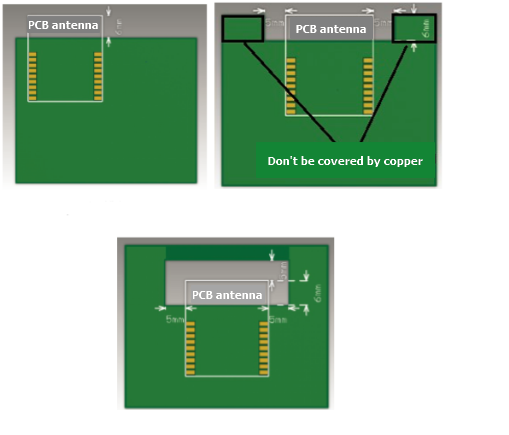
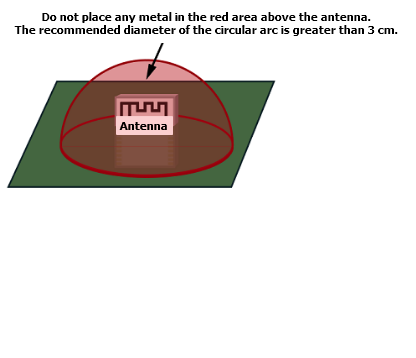
Specifications of antenna connector
There is no antenna connector for this module currently.
Packaging information and production instructions
Mechanical dimensions

Specifications of terminal
The terminal has 4 pins with a spacing of 2.54 mm between each other. Detailed parameters are as follows:
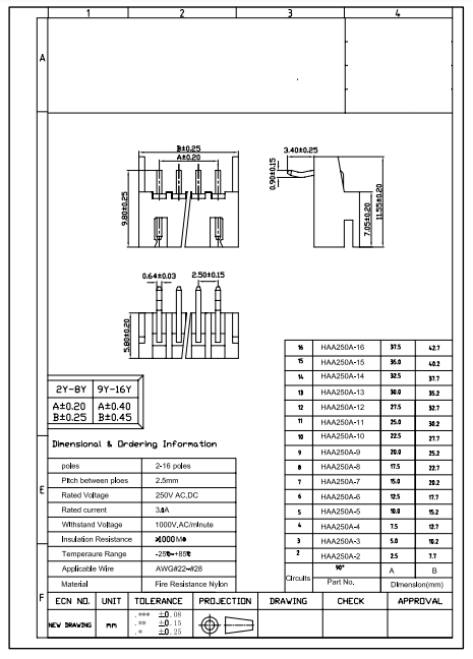
Production instructions
Storage conditions for a delivered module are as follows:
- The moisture-proof bag must be placed in an environment where the temperature is below 30°C and the RH is lower than 85%.
- The shelf life of a dry-packaged product is 6 months from the date when the product is packaged and sealed.
Caution:
- In the production process, all operators must wear electrostatic rings.
- During operation, strictly prevent the module from getting wet or dirty.
Recommended oven temperature curve
We mount the PCB with the SMT according to the following temperature curve. The peak temperature is 245°C.
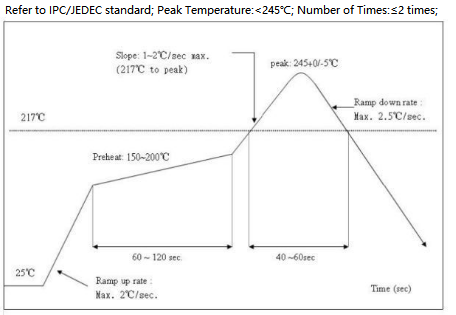
Storage conditions
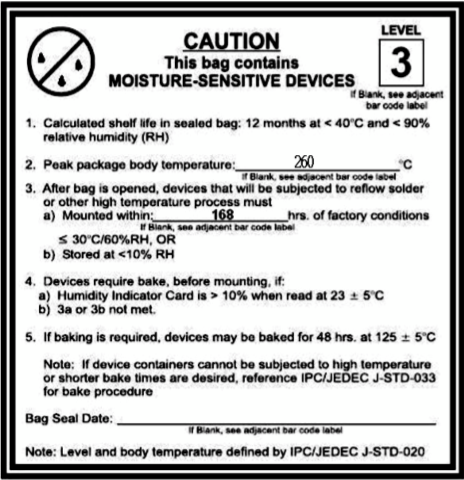
MOQ and packaging information
| Product model | MOQ (pcs) | Shipping packaging method | Modules per carton (pcs) | Reels per carton (reel) |
|---|---|---|---|---|
| TYJW1.1 | 400 | Bubble bags | 200 | 2 |
Is this page helpful?
YesFeedbackIs this page helpful?
YesFeedback





